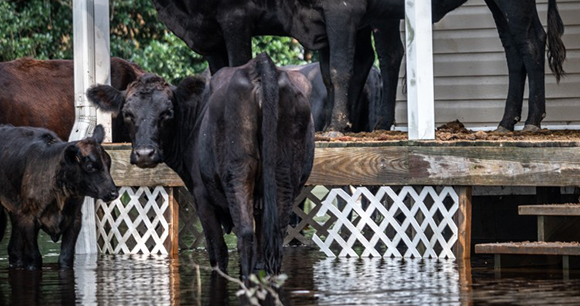
The Emergency and Disaster Preparedness for Farm Animals Act—introduced in the House of Representatives by Rep. Steve Cohen (D-TN)—would require farmers and ranchers to have and implement a preexisting disaster preparedness plan in order to receive federal assistance for the loss of farmed animals during extreme weather events. This legislation would help prevent the suffering and untimely deaths of countless farmed animals, mitigate damage, and save taxpayer money.
Summary of Bill Provisions
The Emergency and Disaster Preparedness for Farm Animals Act would amend federal law related to supplemental agricultural disaster assistance following adverse weather events. It would condition payments dispersed under the USDA’s Livestock Indemnity Program (LIP) for losses related to such events on applicants having fulfilled the following criteria: (1) Prior to the death of the livestock upon which the claim is based, the producer files with the USDA a disaster preparedness plan to prevent livestock injuries and/or deaths. The plan must be specific to the operation’s size and livestock and account for the various adverse weather events that may be expected to impact operations in that region. (2) Within 30 days of the injury and/or death of the livestock, the producer provides the USDA with a description of how the plan was implemented.
With respect to loans issued under the USDA’s Emergency Loan Program to replace livestock, the bill would similarly require producers seeking loans to develop a disaster preparedness plan that is specific to the operation’s size and livestock and accounts for the various adverse weather events that may be expected to impact operations in that region.
Why This Legislation Is Necessary
Each year, hundreds of thousands to millions of farmed animals are killed due to extreme weather. According to public records obtained through the Freedom of Information Act, producers received compensation through the USDA’s Livestock Indemnity Program (LIP) for over 2.3 million animals killed during the years 2021–2023. In 2018, approximately 5.5 million domestic fowl and pigs perished from Hurricanes Florence and Michael, and in 2020, over 100,000 domestic fowl died in Louisiana in the aftermath of Hurricane Laura. Winter storms in the past decade have also wreaked havoc on farms; in 2023, thousands of cattle, sheep, and goats were reportedly killed across Wyoming. In 2021, a deep freeze in Texas resulted in the death of hundreds of thousands of farmed animals, including 455,000 chickens who either froze to death due to power outages, were crushed by barn roofs that caved in under the weight of snow and ice, or otherwise died from lack of food or water. In recent years, extreme heat has also killed many farmed animals. According to media reports, hundreds of cattle in Iowa died as a result of extreme heat and humidity in 2023, and in 2022, a heat wave in Kansas killed at least 2,000 cattle.
Congress and the USDA have created various disaster assistance programs over the years—including the Emergency Loan Program and LIP—to compensate producers for such losses. According to federal data, over $500 million has been distributed to farmers and ranchers under LIP since 2008. From 2021 through 2023 alone, nearly $170 million was distributed under the program. Despite the large price tag associated with these programs, producers are not required to demonstrate they took any steps to protect their animals from extreme weather before receiving compensation.